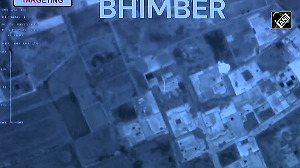'We have to be prepared on the borders to withstand Chinese expansionist designs.'

Three years have passed since Chinese troops attacked Indian soldiers in the Galwan Valley on the night of June 15-16, 2020 and killed 20 Indian troops in cold blood.
Three years and more have passed since the People's Liberation Army's incursion into eastern Ladakh.
Multiple rounds of discussions have taken place between Indian and Chinese army officers and diplomats, but the Chinese refuse to withdraw to its pre-April 2020 positions in eastern Ladakh.
"The Chinese strategy of nibbling away or salami slicing is a peacetime tactic of taking advantage without fighting a war. "It is part of China's expansionist or revanchist policies. We have to ensure that this nibbling is denied by locating people as far forward as possible. Any attempt to expand territory must be fought vigorously," says Lieutenant General Rakesh Sharma, retired, former commander of the Fire and Fury Corps based in Leh.
The Fire and Fury Corps guards the border in Kargil, Siachen and Eastern Ladakh, which includes both the Pakistan and China frontiers.
"It also conveys the message that if China wants to expand further, it will have to fight a war," General Sharma tells Rediff.com's Archana Masih in the first of a two-part interview.
Three years later, do we have a better understanding of what the Chinese aims and intentions are in Eastern Ladakh?
It is imperative to see the overall Chinese motivations.
There is an attempt by the Chinese hierarchy to aggressively push the issues of sovereignty, territorial integrity and nationalism within their country. Therefore, they are attempting to resolve territorial issues in their favour in the best possible way.
India's growth trajectory and geostrategic location poses a risk to China. China is excessively dependent on the Indian Ocean Region. The Indian peninsula juts 2,000 kilometres into the Indian Ocean which has made India a geopolitical challenger to China.
China wants to try and contain India or deny India the possibility of rising to its potential. Therefore, the settlement of the border is not in the Chinese mindset.
China wants to keep India under pressure.

Despite several rounds of talks between Indian and Chinese army officers, the PLA refuses to withdraw from the Depsang Plain and Demchok. Photograph: ANI Photo
In such a long almost 3,500 kms border, why do you think China chose the Eastern Ladakh front for a stand-off with India which has gone on for more than three years?
In view of India's growth trajectory, China probably felt that it could resolve the most problematic part of the entire border, Eastern Ladakh, in one stroke.
Hence, the entire Aksai Chin region, as it is close to the perceived Line of Actual Control was put under test by the Chinese.
They undertook an operation which obviously had been planned over a period of time to address Eastern Ladakh starting from Raki Nala to Demchok and attempted to reach their claim line according to the November 7, 1959 line.
[The LAC proposed by then Chinese premier Zhou Enlai in a letter to then prime minister Jawaharlal Nehru dated November 7, 1959. India has never accepted this line.]
According to what has appeared in the press after the 18th round of military talks, the Chinese are demanding another buffer of 15-20 kilometres and are attempting to push the buffer down to Burtse which is an ITBP post -- and that lies on the November 7, 1959 line.
That is one region where the Chinese have not reached the November 7, 1959 line because they are in a bottleneck in that area close to the Depsang Bulge.
All other areas -- except, of course, the area of Pangong Tso [and Burtse area] -- they have willy-nilly approximately, reached what they perceive as the November 7, 1959 line.
In Pangong Tso, the November 7, 1959 line would come to Finger 3 or Finger 4 for China, but since the Indian Army carried out an operation on 29/30 August 2020 and occupied the Kailash range, the Chinese had to relent and move back to Finger 8.
On these two significant points there is some discrepancy into what the Chinese are seeking. The Kailash range has become a kind of buffer and no side is occupying it.
China has attempted to reach its perceived line, even though the November 7, 1959 line was an arbitrary line and had no legal standing or history. China wants to reiterate this line because it wants to push a hard stance on territorial integrity and sovereignty to its people.
China has undertaken mammoth infrastructure development, deployed forces and changed the demographic pattern along the Line of Actual Control.
It has conducted military exercises, constructed helipads, airfields, built habitat and villages -- all these are to create a threat across the Line of Actual Control. This is in accordance with President Xi Jinping's of-repeated promise to transform the PLA into a 'Wall of Steel' across its territorial frontage.
The PLA's actions in Sinkiang facing Eastern Ladakh and in Tibet is China's way of stating that they have created a 'Wall of Steel' to defend their sovereignty and territorial integrity which also poses a permanent threat to India.
India has to hold onto its side with an equal, firm footing and adequate force.

This has connected the people of Zanskar with Leh and Kargil. Photographs: ANI Photo
How should India respond to the building of infrastructure, military exercises and creation of this intended 'Wall of Steel'?
The Chinese strategy of nibbling away or salami slicing or chewing away territory is a peacetime way of taking advantage without fighting a war.
It has been colloquially called gray zone warfare.
The Chinese have tried this in RakuLa in Sikkim and Yangtse in Arunachal Pradesh. It was their attempt at nibbling, but was denied to them by our troops.
It is part of China's expansionist or revanchist policies. We have to ensure that this nibbling is denied by locating people as far forward as possible. Any attempt to expand territory must be fought vigorously.
In peacetime, we have to be right there at those locations so that the PLA cannot use its infrastructure to nibble or swallow our territory. It should not be permitted in any manner whatsoever and that is what is meant by peacetime denial.
It also conveys the message that if China wants to expand further, they will have to fight a war. They cannot indulge in quiet nibbling as they had done earlier in 2020.
Secondly, in view of the deployment of PLA troops in closer proximity, the military exercises conducted and the infrastructure that has been built -- airfields, blast pens etc -- the Indian armed forces have to be prepared.
The situation can escalate any time and we have to have a defensive layout and also maintain reserves to deny them their objective.
We have to be vigilant to any escalation that may ensue, in case their peacetime manoeuvring or peacetime nibbling is denied.
In both situations we have to be prepared on the borders to withstand Chinese expansionist designs.
Feature Presentation: Aslam Hunani/Rediff.com











